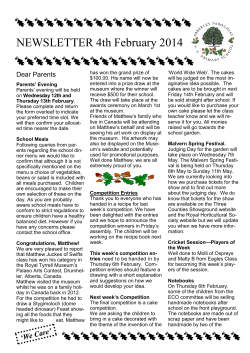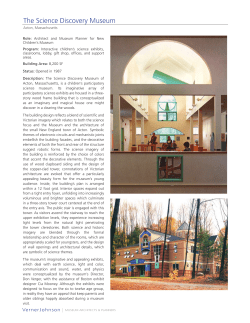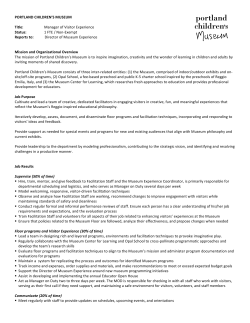
The UK as a Destination in Travel & Tourism
The UK as a Destination Written to support BTEC Level 3 qualifications in Travel & Tourism Contents Aim & Outcomes 4 Introduction to the UK as a Destination Incoming & domestic tourism Types of UK tourists Models of tourism development Trends in tourism 7 8 9 11 17 The UK’s physical features Introduction The location and structure of the UK Capital cities The coastline of the UK Islands of the UK National parks Mountain regions Visitor attractions 27 28 29 31 34 35 42 47 53 Locate UK’s gateways Transport Routes - air Transport routes - waterways Transport routes - sea Transport routes - rail Transport routes - roads 65 66 75 78 86 91 England England – An overview The North The Midlands The South London Validation 99 103 137 171 193 223 247 Scotland Scotland - An overview Southern Scotland Central Scotland Northern Scotland Validation 261 265 291 309 337 359 Wales Wales - An overview North Wales Mid Wales South Wales Validation 373 377 395 415 425 459 Ireland Ireland - An overview Northern Ireland Southern Ireland Validation 473 477 493 513 573 Final Validation 587 Final Assignments 599 Types of UK Tourists There are many types of tourists to and within the UK and Ireland. These can be categorised as domestic and international tourists, by age group, by party size and a specific purpose for the holiday. These include: • History/Culture: People travel to learn about the history of a city or country, or learn about the people who live there, or their ancestors. • Relaxation and beach holidays: People might want to relax on the beach and in the sun. The UK and Ireland are not renowned for warm weather but certain places have a better climate than others and are ideal for beach holidays. For example, Devon and Cornwall. • Special interest and sport: Some people travel to do an activity which they cannot do at home. For example, surfing in Newquay, hill walking in the Peak District or skiing in Scotland. • City break: Short breaks to cities are becoming more popular. Just getting away for a few days to somewhere different can make you feel better and you can take in the sights and sample the atmosphere. • Visiting friends and relatives (VFR): People sometimes visit family and friends in another part of the UK or from another country such as Canada or Australia. • Business: The UK & Ireland have excellent conference and exhibition facilities, especially in London, Birmingham, Manchester, Glasgow, Belfast & Dublin. • Medical: An increasing number of people travel to hospitals to get specialist treatment or operations. Tourists will come in differing ages and sizes. For example, on their own, as a couple, as a family or in groups. Case Study: Blackpool Exploration: This is when small numbers of visitors are attracted to Blackpool for its great beaches and attractive landscape. At this stage, the local people have not developed the tourism industry. Involvement: The picture above shows the involvement of some local people and tourism. In the foreground you can see tourists looking out to see and in the background you can see buildings that could be a hotel or guest house. Development: The picture above shows the development of Blackpool because of the new train tracks built to Blackpool providing transport from many of the towns and cities of England. Hotels and Guest houses are opened to meet growing demand from this influx of larger tourist numbers as the destination grows. Exercise 8.2 Evidence towards P1 Name the national parks numbered on the map below 1. 2. 3. 4. 5. 6. 7. 8. 9. 10. 6 Visitor Attractions England has a large and varied range of visitor attractions, from peaceful country parks and small rural attractions to exciting theme parks with state-of-the-art rides and world famous museums and galleries. Some attractions are located in rural areas and others within cities. Visitor attractions are either natural or man-made and can be categorised under the following headings: • Ancient monuments: historic buildings or their remains, such as fortifications and burial mounds, that have been designated as worthy of preservation • Historic properties: castles, houses, palaces, , town centres, villages, heritage sites • Museums and Art Galleries: subject-specific museums, such as those based on transport or costume; site-specific museums, such as Ironbridge Gorge; or area-based museums containing national, regional or local collections. Galleries with collections of fine and contemporary art, including paintings, sculpture and photography • Industrial or Craft centres: mostly sites and structures identified with specific industrial and manufacturing processes, such as mining, textiles and transport • Leisure and theme parks: large scale attractions, normally featuring a variety of rides and other forms of entertainment • Farms • Steam/Heritage railways • Places of worship: cathedrals and churches All of these areas will be looked at in specific detail throughout this publication. 8 1 2 3 4 Left blank for your own notes Regions England is divided into nine distinct areas or regions - each with its own unique personality for things to do and places to see. The nine regions are: • • • • • • • • • The South East The South West London The East Midlands The West Midlands The East of England The Northwest Yorkshire and Humberside The North East. We will be looking at all these areas separately. The capital city of England and the UK is London, situated on the River Thames and is a common stopping off point for people travelling to Europe and within the UK. Other popular tourist destinations in England include Stonehenge, the Roman city of Bath, the university towns of Oxford and Cambridge, Stratford upon Avon, Canterbury, York, The Norfolk Broads and the Lake District. Last year, the most visited cities in England were: City Visitors (thousands) London Manchester Birmingham Oxford Cambridge Brighton/Hove York Bristol Bath Newcastle-upon-Tyne Liverpool Nottingham 47900 2440 2360 1520 1220 1000 990 946 930 800 780 740 UNESCO World Heritage Sites All of the sites on the UNESCO World Heritage List are considered to be of worldwide importance because of their natural features or their significant contribution to world culture. There are two main categories of sites: natural and cultural. These are the current UNESCO Cultural Heritage Sites in England: • • • • • • • • • • • • • • • • Blenheim Palace Canterbury – Cathedral, St. Augustine’s Abbey & St. Martin’s Church City of Bath Cornwall and West Devon Mining Landscape Derwent Valley Mills, Derbyshire Durham – castle and cathedral Hadrian’s Wall Ironbridge Gorge Liverpool - Maritime Mercantile City Maritime Greenwich Royal Botanic Gardens, Kew Saltaire, West Yorkshire Stonehenge, Avebury and associated sites Studley Royal Park and Fountains Abbey Ruins The Tower of London Westminster Palace, Westminster Abbey and St Margaret’s Church, London There is one UNESCO Natural Heritage Site which is the Dorset and East Devon coast. Purpose-Built Resorts The UK has a number of catering locations primarily for the family holiday market. These include: Bourne Leisure Group employs around 12,000 people and is the UK’s number one leisure business. It owns 52 holiday sites comprising Butlins, Haven and Warner Leisure Hotels, all of which offer families and adults accommodation, entertainment and activities. Last year, Bourne was inspired by popular television programmes such as Warner, and in association with BBC Worldwide, launched Strictly Come Dancing-themed holiday breaks, while Haven rolled out the Haven’s Got Talent Competition, which featured celebrity judges. • Butlins: Opened its first ‘holiday camp’ at Skegness in 1936 since when the company has diversified into hotels and time-share apartments, offering family and adult-only holidays. Butlins is famous for its ‘Red Coats’ whose primary function is to entertain the holidaymakers. • Haven: Haven provide three types of holiday; Self-catering, Half Board and Caravan & Camping and offer fantastic facilities, activities and entertainment on their parks. • Warner Leisure Hotels: Short breaks exclusively for adults and with hotels in the UK. • Center Parcs: Conceived as a new type of holiday resort and provides an alternative to a traditional seaside resort holiday. Center Parcs combine a wide range of sporting and leisure activities in natural woodland settings giving them a very tranquil atmosphere. All Center Parcs offer their trademark ‘Subtropical Swimming Paradise’ the temperature of which is maintained at a constant, warm temperature throughout the year. Other on-site facilities offer a variety of restaurants, spas and saunas. Cumbria - The Lake District The Lake District National Park is England’s largest and covers 2292 square kilometres (885 square miles). The Lake District National Park has many special qualities unique to the area. There are over fourteen lakes and tarns although officially Bassenthwaite Lake is the only titled ‘lake’ - the rest are ‘meres’ or ‘waters’. The rocks forming the Lake District provide a dramatic record of nearly 500 million years. Colliding continents, deep oceans, tropical seas, and kilometrethick ice sheets helped shape the landscape we see today. There have been people in the Lake District since the end of the last ice age. There are traces of prehistoric and medieval field systems, archaeological monuments such as stone circles, Roman roads and forts and the remains of the mining, gunpowder and wood-processing industries. The Lake District is made up of vibrant towns and villages and also small quiet hamlets but all offering character and history for the visitor. The central point for the lakes is at Windermere. There are shopping facilities in Kendal and excellent outdoor shops at Ambleside for all your gear. There is plenty of outdoor activities as well as places of historical interest; these include William Wordsworth - Dove Cottage and Museum in the picturesque village of Grasmere and Beatrix Potter Hill Top at the Hamlet of Near Sawrey close to Hawkshead. Liverpool & Merseyside Cultural Liverpool: Liverpool boasts two cathedrals which are major attractions in their own right. The Anglican Cathedral and the Metropolitan Cathedral are fine examples of internationally recognised architecture. Many gems of the National Museums Liverpool fall within the heritage site. The refurbished World Museum Liverpool and Walker Art Gallery are housed in this part of town, while the Tate Liverpool and Merseyside Maritime Museum have their homes on the waterfront, at the Albert Dock, alongside the unmissable Beatles Story. Maritime Liverpool: Liverpool’s port, the second city of the British Empire, provided the gateway to Britain, and a window to the rest of the world, culminating in the vibrant, diverse, international city Liverpool is today. Maritime heritage weaves a rich thread through the city today, from the Three Graces on the Waterfront to the Albert Dock, home of the Merseyside Maritime Museum. A trip across the river on the world-famous Mersey Ferry offers the most dramatic views of the waterfront and Three Graces - the Liver Building, Cunard Building and Port of Liverpool Building. On the Wirral side of the river, you can find the stunning new Spaceport attraction at the Seacombe ferry terminal. Sport in Liverpool: Liverpool boasts two Premiership football teams, Everton FC and five-time European Champions Liverpool - you can tour both stadia for a behindthe-scenes view of the beautiful game. One of the world’s most famous horse races, The Grand National, is run here every April at Aintree. Musical Liverpool: Liverpool is the birthplace of not only The Beatles, but Echo and the Bunnymen, Atomic Kitten, Cream, The Coral, The Farm and Frankie Goes to Hollywood. Take a trip on the Magical Mystery Tour, visit the Beatles Story, Casbah and Cavern (see picture below), or spend some time at Beatles Week, which culminates in the Mathew Street Festival. Eastern Counties Cambridgeshire is home, of course, to the famous University city of Cambridge, noted for its historic colleges, museums, bookshops and punting. Just outside the city is the historic aircraft of the Imperial War Museum. The Cambridgeshire Fens are a unique and distinctive area. To the south is the market town of Huntingdon, birthplace of Oliver Cromwell. Bedfordshire’s main town is naturally the county town of Bedford, noted for its fine river setting and connections to the preacher/author John Bunyan. Leighton Buzzard set on the Grand Union Canal has always been famous for its sand. Essex has England’s oldest recorded town, Colchester, home to a superb Norman castle keep and Roman remains. To the north is Constable Country (Dedham) On the coast, visitors can explore seafaring history at Harwich, the ancient hilltop town of Maldon, the yachting centres of Brightlingsea and Burnhamon-Crouch and the resorts of Clacton-on-Sea, Walton-on-the-Naze and Southend-on-Sea. South west is Epping Forest, haunt of highwayman Dick Turpin, and Waltham Abbey, home to one of the country’s most outstanding Norman buildings Hertfordshire’s main starting point is St. Albans, which has been shaped by over 2,000 years of history, from Roman Verulamium to the magnificent cathedral. South from here is Borehamwood ´Britain’s very own Hollywood´ with its film and television studios. North is Welwyn´s third century Roman baths and the gothic fantasy of Knebworth House. Visitors can see Hatfield House, Queen Elizabeth I´s childhood home. Hertfordshire’s newest attraction is Warner Bros. Studio Tour – The Making of Harry Potter is in Leavesden. It is a behind-the-scenes walking tour. The unique tour will give visitors the first ever chance to visit the real Harry Potter film. Exercise 6.3 1. Which town was the birthplace of Oliver Cromwell? 2. Which county has the Imperial War Museum at Duxford? 3. Which county inspired the artist Constable to paint? 4. What is the name of the royal palace situated in Norfolk? 5. Which is England’s oldest town? 6. What is Borehamwood in Herfordshire famous for? 7. What is the name of Queen Elizabeth’s childhood home situated in this area? 8. What is The Burhams in Norfolk famous for? 9. Which forest in Essex was the haunt of the highwayman, Dick Turpin? 10. What is the name of England’s third largest reservoir in Cambridgeshire? 16 Cornwall & The Isles of Scilly Cornwall is situated in England’s South West peninsula and offers more miles of unspoilt coastline than any other in England. Dotted along the coast are hundreds of beaches - from tiny secret coves to large expanses of golden sand. There are famous resorts and picturesque fishing villages, whilst inland lie ancient settlements, historic market towns and the cathedral city of Truro Cornwall’s capital. Cornwall has plenty of heritage and culture from times past stone circles, Iron Age villages and grand historic houses. There are a multitude of great gardens, all different, which are a joy to explore. A vibrant art scene stemmed from the Newlyn and St Ives schools, and Cornwall attracts artists from worldwide still. A host of writers such as Daphne du Maurier, Rosamunde Pilcher and John Betjeman have all written of the delights of this far flung corner of England. North Cornwall has stunning country houses, medieval castles and many areas to explore including Bude, Crackington Haven, Boscastle, King Arthur’s Tintagel and Port Isaac, all hidden in the most spectacular cliffs in Cornwall. There are market towns at Camelford and Wadebridge and the pretty working port of Padstow. Inland there’s the muted fury of Bodmin Moor and the historic towns of Bodmin and Launceston. West Cornwall is home to Penzance, St Ives, Hayle and of course, Land’s End – the most westerly point of England. You can also visit The Minack open air theatre, perched above clear turquoise sea, and St Michael’s Mount near Penzance. There are magnificent beaches at nearby Sennen and Porthcurno, and for art-lovers, the Tate St Ives, Newlyn Art Gallery and Penlee House Gallery in Penzance are on the doorstep. West & East Sussex West Sussex offers epic views of the South Downs, unspoilt coastlines to explore, historical cities such as Chichester and ancient woodlands in which to get lost. A beautiful rural region where you can experience many elements of England’s history from Fishbourne Palace, the site of a sumptuous Roman palace, to Weald and Downland Open Air Museum and it’s fascinating collection of nearly fifty historic buildings dating from the 13th to the 19th century, together with farm animals, woodland walks and a picturesque lake. Seaside resorts include Worthing, Littlehampton and Bognor Regis. East Sussex is renowned for offering both the rural and urban, from unspoilt countryside, medieval cottages, castles and picturesque villages, to the thriving city of Brighton with its mix of rakish eccentricity, buzzing music scene and bountiful boutiques. Further along the coast are the Seven Sisters chalk cliffs. East Sussex is steeped in history and culture: • The site of the Battle of Hastings in 1066 • Bateman’s - the home of Rudyard Kipling, author of The Jungle Book • Charleston Farmhouse, the country home of the Bloomsbury Group. It also has loads of gardens that can be visited, one of the most famous being Sheffield Park Gardens in Sussex. Exercise 8.4 Answer the following questions concerning East & West Sussex, Kent and Hampshire. 1. Which county is Beachy Head situated in? 2. Which castle did Ann Boleyn grow up in? 3. Where would you be if you were shopping in The Lanes? 4. Where would you find the Dickens Centre? 5. In which city can you visit a Titanic Exhibition? 6. In which cathedral was St Thomas Becket murdered? 7. In which town would you find the new Turner Contemporary gallery? 19 Introduction London used to be the world’s largest metropolis and although it has ceded that title to the sprawling cities of the southern hemisphere, it’s still a huge bewildering place. London is in fact two cities - ‘The City of London’ usually just called ‘The City’, and ‘Westminster’, which lies to its west. For all intents and purposes the West End (everything to the immediate West of the City) is now the centre of London. Top London attractions include: Museums: British Museum, Natural History Museum, Science Museum, Victoria and Albert Museum (V & A), National Maritime Museum, Design Museum, Imperial War Museum, Museum of London, Bank of England Museum, Churchill Museum Palaces and historic properties: Tower of London, Buckingham Palace, Kensington Palace, Hampton Court Palace, The Houses of Parliament and Big Ben, Banqueting House, The Monument, and Maritime Greenwich Visitor attractions: Madame Tussaud’s, Tower Bridge Experience, London Eye, London Zoo, London Dungeon, HMS Belfast, Cabinet War Rooms, London Aquarium, Thames Barrier Cathedrals/abbeys: St Paul’s Cathedral, Westminster Abbey, Westminster Cathedral, Southwark Cathedral London’s Railway Stations Geographically, the hub of the UK rail network is London where there are 14 ‘Terminal’ stations, from which run the principal lines that link London with other parts of the UK. The London Terminal Stations are: King’s Cross Fenchurch St St Pancras International Marylebone Euston Paddington Charing Cross Blackfriars Victoria Cannon Street Waterloo London Bridge Liverpool St Moorgate Exercise 1.1 On the map provided locate and name the following bodies of water: Atlantic Ocean Solway Firth 22 North Sea Firth of Forth Pentland Firth The Minch Firth of Clyde Firth of Lorn Moray Firth North Channel Scottish Events Scotland has many events throughout the year some of which we will be looking at throughout this module. Some of the annual events taking place include: The Loony Dook: Celebrate the first day of every New Year, a growing number of people leap into the freezing waters of the Firth of Forth at South Queensferry in fancy dress or just their bathing costumes! Celtic Connections: The biggest winter music festival in the world held in January. Celtic Connections features artists from around the globe. From concerts, ceilidhs and club-nights to drums, drams and dancing Glasgow Film Festival: Over one hundred films will be shown at the festival over ten days in February at Glasgow. With previews, premieres, gala nights and guest appearances, the Film Festival showcases a range of exciting films old and new. Fort William Mountain Festival: A two-week celebration in February of mountains and the culture that surrounds them! The Festival offers a varied and very full programme of lectures, films, activities, exhibitions, plays and music to entertain visitors to the UK’s outdoor capital. Melrose Sevens: Melrose is the birthplace of Rugby Sevens and is a must-see event for any rugby fan. Melrose Sevens draws thousands of spectators in April every year to see rugby played by teams from around the globe. Scottish Grand National Festival: This April event always attracts racing enthusiasts from far and near. The chase is the culmination of the Scottish Grand National Festival, a two-day steeplechasing festival held at Ayr Racecourse. Scottish Pipe Band Championship: This Competition attracts pipe bands from near and far to compete for the national championship. Visitors can see and hear the pipers, drummers and bands battle it out for the prizes. Exercise 9.1 Evidence towards P1 Identify the following Scottish locations: 1. 2. 3. 4. 24 Edinburgh and Lothian The Lothian region of Scotland lies between the southern shore of the Firth of Forth and the Lammermuir Hills. Scottish history saw Lothian subdivided into the shires of West Lothian, Midlothian and East Lothian — leading to the phrase “the Lothians”. Edinburgh is the main city in the area and also the capital of the country. The city makes a dramatic first impression on visitors with the castle sitting above Princes Street with its many shops. It also has the largest zoo in Scotland. It is one of Europe’s major tourist destinations, attracting roughly 13 million visitors a year, and is the second most visited tourist destination in the United Kingdom, after London. Edinburgh is home to an abundance of open spaces, allowing people to escape from the hustle and bustle and to simply unwind in natural and peaceful surroundings. The city’s hidden natural treasure, The Water of Leith, is a popular spot for walkers and features a Visitor Centre with an interactive display on the river’s heritage and wildlife. Edinburgh Events It is also well-known for the annual Edinburgh Festival, a collection of official and independent festivals held annually over about four weeks from early August. The most famous of these events are the Edinburgh Fringe (the largest performing arts festival in the world), the Edinburgh International Festival, the Edinburgh Military Tattoo, and the Edinburgh International Film Festival. Other notable events include the Hogmanay street party (31 December) and the Beltane celebrations (30 April). Aviemore Aviemore is a tourist resort town which is popular for skiing and other winter sports, and for hill-walking in the Cairngorm Mountains and is situated within the Cairngorms National Park. It also has an annual walking festival in May and has plenty of choice for those who like outdoor activities. Britain’s only reindeer herd and Loch Garten Osprey Centre are nearby. One of the highlights here is to go walking in the area. Visitors can also take the mountain railway, which has become one of the area’s leading visitor attractions in its own right. Visitors can travel in comfort and safety for 2km from the Base Station at car park level to the Ptarmigan Top Station. At the top of the mountain is the Ptarmigan Restaurant, which is the highest restaurant in the UK at 1,097m above sea level. Outdoor activities in Aviemore include: • • • • • • • • • • • • • • • • • • • Canoeing Climbing Cycling Gliding Gorge Walking and Canyoning Hill Walking Ice Climbing Kayaking Mountain Biking Mountaineering Navigation Skills Pony Trekking Quad Biking Rafting & Inflatables Rock Climbing Sailing Skiing Snow Holing Snowboarding Exercise 1.1 Mark the following towns and cities on the map: Aberystwyth – Brecon – Caernarfon - Cardiff – Cardigan - Carmarthen - Colwyn Bay – Fishguard – Holyhead – Llandudno - Newport – Rhyl – Swansea - Tenby – Wrexham 27 Exercise 4.4 - Case Study: Swansea Using your resources, examine the city of Swansea and make notes as to why it might feature as a popular tourist destination: Location: Places of interest to visit in the area: Special Events: Nearest Motorway or A road: Nearest airport: 28 Exercise 13.4 1. In which month is the Abergavenny Food Festival held? 2. What is the oldest surviving stone fortification in Britain? 3. In which town would you find the Nelson Museum? 4. Which town is famous for its medieval castle? 5. In which town could you visit Linda Vista gardens? 29 Knock – every year more than one and a half million pilgrims make their way to Our Lady’s Shrine in the basilica at Knock which is known as the Lourdes of Ireland. Foxford is on the banks of the River Moy, its main attraction is the Foxford Woollen Mills and Visitor Centre where you can watch rugs, blankets and tweeds being made. There are craft workshops and a Mill Shop where visitors can purchase goods. Ballina - the largest town in County Mayo standing beside the River Moy, one of Mayo’s best Salmon and Trout rivers. Visitors can visit the Cathedral of St Muredach with its beautiful stain glassed windows. Ballina is also the starting point for the North Mayo Sculpture Trail, which follows the coastal route to Belmullet with its 15 international sculptures. Ballycastle is best known for Ceide Fields, the largest known Neolithic farm settlement in the world.
© Copyright 2025









